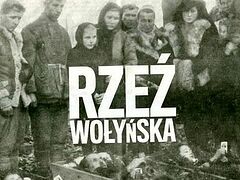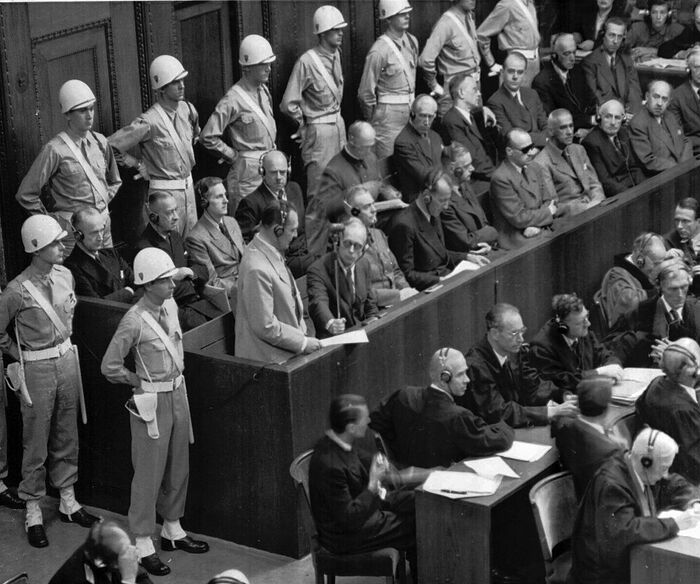 The Nuremberg Trials.Photo: Britannica.com
The Nuremberg Trials.Photo: Britannica.com
This article was written for the sixtieth anniversary of the Nuremberg trials, by Alexander Grigorievich Zvyagintsev (born 1948, Zhitomir), attorney, historian, author of over forty books, and formerly Deputy of the General Prosecutor of the Russian Federation.
Mankind has long ago learned to condemn individual evil-doers, criminal gangs, bandits and unlawful paramilitary formations. The international war tribunal in Nuremberg became the first experience in history of condemning crimes on a national scale—crimes of a ruling regime, its executionary institutions, and upper level political and military actors. Sixty [at the time of this publication] years have passed since then…
On August 8, 1945, three months after the victory over fascist Germany, the governments of the USSR, USA, Great Britain and France signed an agreement to organize a court to condemn the main war criminals. This decision gained approval throughout the world—a severe lesson needed to be taught to the authors and executors of the cannibalistic plans of world domination, mass terror and murder, odious ideas of racial supremacy, genocide, and monstrous destruction and plunder of enormous territories. Soon nineteen more nations joined in the official agreement, and the tribunal gained the full right to be called a People’s Court.
The process began on November 20, 1945 and went on for nearly eleven months. Before the tribunal stood twenty-four war criminals, who were members of the highest echelons of fascist Germany. There had never been anything like it before in history. Also for the first time was the question raised of recognizing as criminal a number of political and state institutions—the ruling members of the fascist party (NSDAP), its Sturmabteilung (Stormtroopers—SA), and the Schutzstaffel (SS) battalions, the Einsatzgruppen (death squads, SD), the secret state police (Gestapo), the government cabinet, the supreme command, and the general staff.
The sentencing was not some speedy revenge against a defeated enemy. The indictment in the German language was handed to the defendants thirty days before the proceedings began, and later they were given a copy of all the documented evidence. The trial guarantee gave the accused the right to defend themselves either personally or with the aid of an attorney from Germany, to intercede for the calling of witnesses, to present proof in their own defense, to provide explanations, question witnesses, etc.
Hundreds of witnesses were questioned in the judgment hall and in the field, and thousands of documents were perused. Also as evidence were the books, articles, and public appearances of Nazi leaders, photographs, documentary films, and film chronicles. The credibility and cogency of this data base removed all doubt.
All 403 tribunal sessions were open. About 60 thousand entrance passes to the judgment hall were distributed. The work of the tribunal had wide press coverage, and it was transmitted live on radio.
From September 30 to October 1, 1946, the People’s Court brought out its sentence. The accused were declared guilty of serious crimes against the world and humanity. The tribunal sentenced twelve of them to death by hanging. Others were given life or long prison sentences. Three were acquitted.
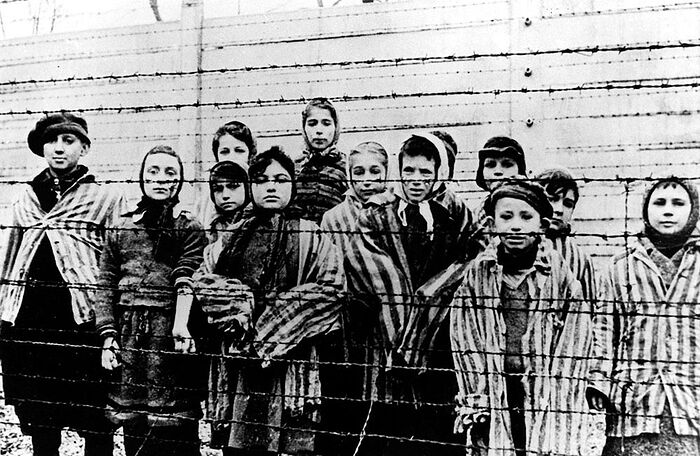 Children at Auschwitz-Birkenau taken by a Soviet photographer during liberation. Photo: Yad Vashem
Children at Auschwitz-Birkenau taken by a Soviet photographer during liberation. Photo: Yad Vashem
The main units of the national-political machine, which the fascists had developed to the point of a diabolical ideal, were declared criminal. However, the government, supreme command, general staff, and Stormtroopers (SA)—against the opinion of the Soviet representatives—were not declared criminal.
Member of the International War Tribunal from the USSR I. T. Nikitenko did not concur with this removal (beside the SA), nor with the acquittal of the three accused. He also considered the life sentence given to [Rudolf] Hess to be too soft. The Soviet judges expressed their protest in a Special Opinion. It was read out at the trial and is part of the sentencing.
Yes, there were serious disagreements on certain problems amongst the judges of the tribunal. But they can by no means be compared with the clash of views concerning one and the same events and persons that would unfold in the future.
But first about the main thing. The Nuremberg trial acquired universal and historical significance as the first and largest judicial act of the United Nations up to that time. United in their rejection of violence against man and the state, the peoples of the world proved that they can successfully resist universal evil and render justice.
The bitter experience of the Second World War forced everyone to look anew at many problems facing mankind, and to understand that every person on Earth bears responsibility for the present and the future. The fact that the Nuremberg trial came to pass says that the heads of states do not dare ignore the firmly expressed will of the people and lower themselves to double standards.
It would seem that before all countries the brilliant prospect of collective and peaceful solutions to problems was opened, to bring a bright future without wars and violence.
But unfortunately mankind too quickly forgets the lessons of the past. Soon after Winston Churchill’s Fulton speech, despite the convincing collective action at Nuremberg, the victor nations divided into military-political blocks, and the work of the United Nations was complicated by political infighting. The shadow of the “cold war” descended upon the world for long decades.
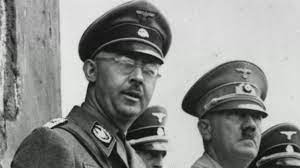 Himmler and Hitler. Under these conditions, powers were activated that wished to revisit the conclusions of the Second World War, to denigrate and even reduce to nothing the leading role that the Soviet Union played in defeating fascism, placing an equal sign between Germany—the aggressor nation—and the USSR, which fought a just war, and at an enormous cost in lives, saved the world from the horrors of fascism.
Himmler and Hitler. Under these conditions, powers were activated that wished to revisit the conclusions of the Second World War, to denigrate and even reduce to nothing the leading role that the Soviet Union played in defeating fascism, placing an equal sign between Germany—the aggressor nation—and the USSR, which fought a just war, and at an enormous cost in lives, saved the world from the horrors of fascism.
A large number of publications, films, and television programs have come out that distort historical reality. In the “works” produced by former “brave Nazis” and numerous other authors, the leaders of the Third Reich are whitewashed and even made out as heroes, and the Soviet military leaders are blackened, without any regard for the truth and the actual sequence of events. According to their versions, the Nuremberg trial and the pursuit of war criminals as a whole is nothing more than an act of vengeance by the victors over the defeated. Moreover, a typical trick is being used—to show famous fascists in everyday life. Just look, they suggest—these are ordinary and even nice people, and not at all executioners and sadists.
For example, Reichsführer of the SS Himmler, the chief of the most odious punitive organs, is featured as a man of gentle nature, a proponent of animal rights, and a loving father, who hated any impropriety against women.
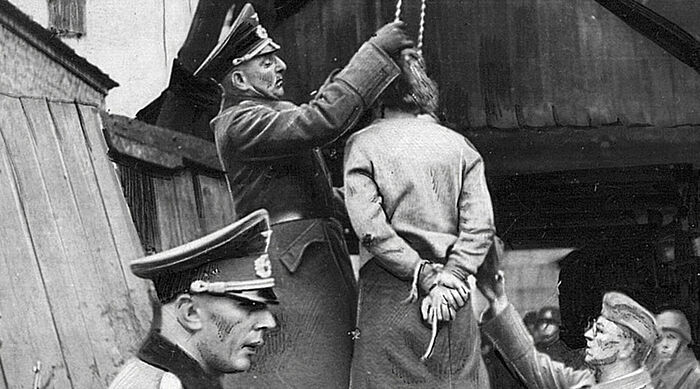 An execution of a Russian woman by the SS. Photo: RF Ministry of Defense.
An execution of a Russian woman by the SS. Photo: RF Ministry of Defense.
Who was this “gentle” nature in fact? Here are the words of Himmler, which he publicly pronounced: “How Russians feel, how Czechs feel, is of total indifference to me. Whether other peoples live well or die from hunger interests me only to the extent that we can use them as slaves for our culture; but everything else is of no matter to me. Whether ten thousand Russian women die of exhaustion during the construction of antitank trenches matters to me only inasmuch as those trenches are built for Germany…”
This more resembles the truth. This is truth itself. This revelation corresponds fully to the image of the creator of the SS—the most advanced and sophisticated repressive organization; the creator of a system of concentration camps that horrify to this day.
They even find warm colors to paint an image of Hitler. According to this fantastically voluminous “Hitlerology” he was a brave warrior of the First World War, with an artistic nature—an artist, an expert in architecture, a modest vegetarian, and an exemplary statesman. There is a point of view that if the führer of the German people had ceased his activities in 1939, without starting a war, he would have gone down in history as a great politician of Germany, Europe, and the world!
But is there any power that can free Hitler from responsibility for the aggression he put into play, for the bloodiest and cruelest world war? Of course, the positive role of the United Nations in the work of the postwar peace and cooperation exists, and that is absolutely indisputable. But it is also undoubtable that this role—both then and now—could have been much weightier.
Fortunately, global conflicts haven’t happened, but military blocks have often balanced on the edge. There has been no end to local conflicts. Small wars with no few casualties have broken out, and in certain countries terrorist regimes have arisen and become entrenched.
The cessation of opposition between the blocks and the emergence in the 1990s of a unipolar world has not added resources to the United Nations. Certain political scientists even express, to put it mildly, the very controversial opinion that the United Nations, in its present form, is an outdated organization, one which corresponded to the reality of the Second World War but not at all to today’s demands.
We are forced to state that the recidivists of the past who exist in our days in many countries more and more often resound with a loud echo. We are living in a troubled and unstable world, becoming increasingly fragile and vulnerable year by year. The contradictions between developed and other nations are becoming sharper. Deep cracks have formed along the borders of cultures and civilizations.
A new, large-scale evil—terrorism—has arisen and quickly grown into an independent global power. It has much in common with fascism, in part by its intentional disregard for international and internal law, and total denigration of the morals and values of human life. Unexpected, unpredictable attacks, cynicism, and cruelty with massive casualties is sowing fear and horror in countries that would seem to be well protected from all threats.
In its most dangerous—international—variations, this phenomenon is directed against all civilization. Today it already presents a serious threat to mankind’s development. We need a new, firm, and just word in the struggle with this evil, similar to what the International War Tribunal said sixty years ago to fascism.
The successful experience of opposing the aggression and terror of the times of the Second World War are relevant to this day. Many of them are directly applicable, while others require rethinking and development. But you can draw your own conclusions.
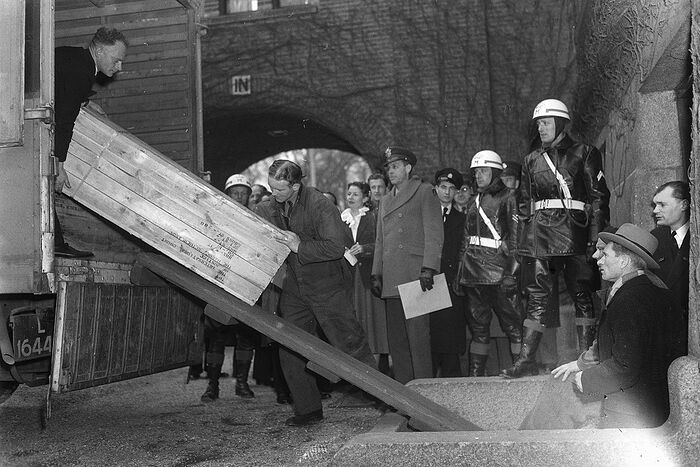 Transfer of the Nuremberg Trial Archives to the Peace Palace, March 14, 1950. Photo: National Archives of the Netherlands / ANP, CC0).
Transfer of the Nuremberg Trial Archives to the Peace Palace, March 14, 1950. Photo: National Archives of the Netherlands / ANP, CC0).
Much to the credit of earlier unpublished materials, testimony of eye-witnesses, through recently declassified archival documents it has been possible to more fully and comprehensibly review the Nuremberg trials, discover its unknown pages, understand the motivation for the tribunal participants’ behavior and the actions of heads of states and governments in the historical context.
It is no secret that the popularizers of fascism have a particular influence on young minds, which nurtures a huge danger for future generations.
This author discusses in detail in his scholarly monograph, The Nuremberg Alarm: Reportage From the Past, Addressed to the Future (Moscow, 2006), presents them from the angel of his own suppositions and newly revealed facts. In the book, certain widespread stereotypes and myths are debunked or disavowed. Time not only buries secrets, it also reveals them, even after decades have passed. Perhaps the author was luckier than his predecessors who researched the history of the Nuremberg trials, for beginning from 1970 he was able to meet with Roman Andreyevich Rudenko, hear his presentations, including his recollections of the Nuremberg trials,
which have always and everywhere become a subject for discussion. About everything that was connected with Nuremberg, about the work of Roman Andreyevich Rudenko, the author was told by not only Rudenko’s brothers—Nicholai Andreyevich and Anton Andreyevich—but also other relatives and close co-workers, including those who worked directly under his direction in Nuremberg. The documents and photographs they presented became invaluable testimony for factual investigation, in the authoritative opinion of both Russian and international historians.
Time is an austere judge. It is absolute. Not determined by people’s actions, it does not forgive a disrespectful relationship to verdicts once passed—be it a specific person or whole nations and states. Unfortunately, the hands on its clockface never show mankind their vector of movement, but inexorably counting down the moments, time eagerly writes fateful letters to those who try to take liberties with it.
Yes, mother-history has at times not been so uncompromising, and placed the implementation of the decisions of the Nuremberg Tribunal on the very weak shoulders of politicians. Therefore, it is not surprising that the brown hydra of fascism has again reared its ugly head in many countries of the world, and the apologists of terrorism practice their shamanism in recruiting every day more and more new proselytes to their ranks.
The work of the International War Tribunal is often called the “Nuremberg epilogue”. This metaphor is quite justified with regard to the punished heads of the Third Reich and disbanded criminal organizations. But as we see, evil has shown itself to be more tenacious than many imagined then, from 1945 to 1946, while we were still in the euphoria of the great victory. No one today can affirm that freedom and democracy has been confirmed finally and irreversibly in the world.
This begs the question: How much and what effort is required in order to draw concrete conclusions from the experience of the Nuremberg trials, to embody them in good deeds and to make them the prologue for creating a world order without wars and violence, founded upon real non-interference in the internal matters of other countries and peoples, with respect for personal rights?



